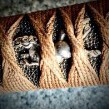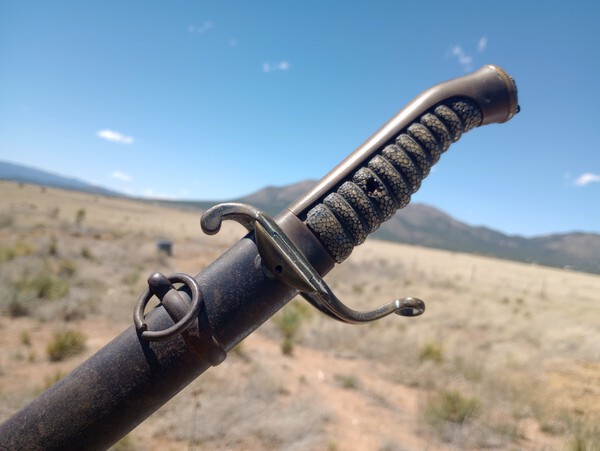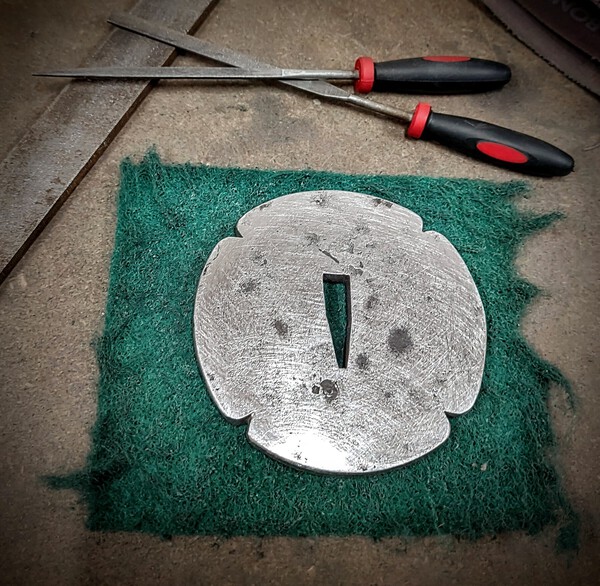-
Posts
37 -
Joined
-
Last visited
Content Type
Profiles
Forums
Events
Store
Downloads
Gallery
Everything posted by Garrett Petrie
-
@ROKUJURO I had typed out a more detailed response, but it failed to send for some reason... My break time is almost over, so I'll have to be quick. Gotta get back to work. The blades are most assuredly stainless steel of some kind, not sharpened. A daisho, displayed on a black-painted katanakake. Both swords have fuchi and kashira of stamped metal. The tsuba are cast, with the English letters to spell out "Made in Japan" as part of their decoration. The ito is synthetic, as is the samegawa. The saya are wooden, and a surprisingly good fit on both swords. The saya have painted-on koiguchi and kojiri. They were a recent gift from my father in law. He purchased them in Las Vegas, Nevada, U.S.A., back in the 1990's. Have a great day
-
Greetings,
I want to take a minute to thank everyone who has offered comment, input, feedback and especially answered questions.
This is a great resource.
Thank you
Have a great day
-
Greetings Members of the Board, I have little time to respond today, unfortunately. I also have very limited access to Internet on any given day, and even less skill at using it effectively. So, for all of that I appreciate everyone's patience and understanding. I mostly wanted to take a minute away from a hectic day, to thank everyone who has taken valuable time away from theirs to comment and offer input. I truly appreciate it. Everyone here has offered valuable insight and information that I will apply to my learning experience. So thanks again. I also need to make one thing very clear. I am not working on true nihonto. I have two antique Japanese swords, both of which are in need of qualified restoration work. But to be very, very clear: I am not doing anything with those swords, other than storing them carefully and keeping them safe. I have two much more contemporary Japanese swords, which are indeed made in Japan, but for the tourist trade. Those are only for decorative purposes. The only actual itomaki, or tsukamaki, that I have undertaken has been with a replica, modern reproduction blade. I would probably have taken an entirely different approach to an actual Japanese made blade. I really don't pretend to know very much, or claim that I'm qualified to pursue the attempts that I have made, but just so that everyone here understands perfectly well: I have too much respect for nihonto, and the craftsmen that forge them, to subject them to my amateur efforts. Probably I never will... But if I did, I'd spring for the genuine Japanese Honoki wood. Have a great day
-
@ROKUJURO Apologies, I meant to say "tsuba"... I made all the parts I listed, including the tsuba. It's all a work in progress. My goal is not necessarily to finish the sword, after all, but to learn how it's done. Have a great
-
@ROKUJUROGreetings, I absolutely agree. I'm here because I know I have a lot to learn. In the short time I've been here, I've already received valuable information. I AM interested in learning the proper methods and acquiring proper tools. I did mention a book that was suggested, which is on my list to add to my humble library. I also am very interested in contacting anyone who would be willing to share their time, and who has experience with any of these traditional crafts. I do not yet know who they are, but I'm interested in meeting them. I used Box Alder wood because it has similar characteristics as Honoki, but I can more easily obtain it. I am not unwilling to use Honoki, just don't know where to find it. Part of what I find most appealing in traditional Japanese art, as far as I understand it, is the refined use of natural materials. I think that it connects the artist, the viewer, and the items that are created, with the natural world around the artist. Obviously this would be a connection with Japan. To those artists and craftspeople, a connection to home. I'm using the tools I have, because they are the tools I have. If I really wanted to get serious about it, I would also have to get rid of my blower and make a box-bellows, and then cut the legs off my forge and put the anvil on the floor. I am using charcoal, but it's made from domestic species of hardwoods. I couldn't possibly afford to import Japanese charcoal for my work. Ultimately, I could probably forge my own tools, in some cases anyway, but I'm going to have to work with what I already have in many other cases. The sword I'm working on is a modern blade. I originally thought that by practicing on a reproduction sword I might eventually achieve a level of skill that would be required to comfortably work on an original antique sword in my care. Today I still feel like the antique sword should be restored, but I'm not going to be the one to do it. Or in other words, the most valuable thing I've learned about the traditional Japanese crafts is that they require more time and devotion to achieve mastery of, than I will likely be able to invest. It's not because I have no respect, or don't see the value in such an investment, but because I can only invest so much. I first started on the sword I am working on, when I still had a horse. Unfortunately, my horse died. Of course I'm not a Japanese Samurai, but I am naturally interested in their horsemanship and related horse-culture. I just don't know too much about it... Actually, I'm interested in the ways people all over the world have been impacted by their relationship with horses. So I originally thought it would be appropriate to attempt to recreate the Tachi form. I really didn't understand what that meant fully, and the blade I have to work with is probably not the best length for it, and probably doesn't have the proper curve, sori(?), and it's not signed in the correct place to be worn as tachi. But to answer your question: my choice was not arbitrary either way. I'm learning every day. I learn more from mistakes I've made than from anything else. So, to answer another question you have, I can benefit from advice as much as criticism. By being told "you're not doing this right", I'm learning that I should consider a different approach, perhaps. To answer your other question, I do not have a set of parts lying around that I just decided to go with because they are what I had. I had a blade only. I have made the habaki, seppa, tsuka, fuchi and tsuka shitaji. I have yet to make the kashira, and will as time permits. I have a stingray skin for the samegawa and some ito. This will be my second attempt at finishing the sword. Already I think it's better than my first attempt, but I know I am just getting started. I have much to learn. As always, I appreciate your time. I have no desire to offend anyone, and if my approach to learning has insulted, or shown any disrespect, I regret that sincerely. I maintain my curiosity, but I will meditate upon a more thoughtful approach to satisfying it. Have a great day
-
@ROKUJURO Greetings, As always, I appreciate any assistance. I'm sure your time is valuable, so thank you again. I did not invest in Honoki wood, or forge Japanese style chisels. I did, however, use box alder wood from a stand of trees I know well. Its possible I could have found Honoki, or had it shipped here from Japan, but it seems impractical. Further, I prefer the idea of connecting to the natural world around me, through use of the natural material I find in my own immediate environment. As I work with the Alder wood, I am reminded of the spring fed stream that runs through the grove, and I am retuned to the calm and quiet state of being I tend to find there. In shaping the tsuka shitaji, I used a few different online resources (Japanese YouTube videos, and a couple of different websites). I will invest in books as the opportunity presents itself. I really am just getting started. It has also been recommended that I look for a particular DVD on the subject. It's pricey, but probably worth the investment. Again, as the opportunity presents itself. But I'm also looking at a hundred bucks worth of silk ito, and about fifty dollars worth of samegawa, every time I do this. So... The new hobby is already adding up to be an expensive one. At least the rice I used for glue was pretty affordable... I will confess I used jasmine rice, probably not grown in Japan. But it was available on my pantry shelf. I only use hand tools. I have a small Japanese saw (Chinese manufacture) and Swiss made wood chisels. I may attempt to make some Japanese style planes someday, but for now I'm using antique box planes I already had on hand. I have done my best to follow traditional methods, in so far as I am aware of them, and able to reasonably pursue them. But as I said, I'm just getting started. I also think it's unlikely I could apprentice with a tsuka maker (assuming I found one anywhere near where I live), and still work my regular job, and still properly maintain my small acreage and livestock. I can however satisfy my curiosity and exercise my freedom, by casually investing time and a little money working on my own projects. I have absolutely no interest in performing restoration work on original swords, especially those that belong to other people. I am very curious to learn more about how these things are done, but will never be ambitious enough to work on a real nihonto myself. The curved shape is intentional. It essentially follows the sori of the blade and nakago. I might be mistaken, but I think it's usually called morozuri (?) and most often found on tachi. I like the feel in hand when making cuts. I don't use the proper tatami mats (you guessed it: too costly for me), but I do grow my own Pampas reed, that I bundle together for cutting targets. If I tried to grow any variety of bamboo here I wouldn't likely be greeted with success. I'm totally receptive to criticism and differing opinions, and sincerely thankful to anyone who takes the time to offer them. So far I've really enjoyed learning through my mistakes, and the feedback of people who are more experienced. I hope that this forum helps me to continue in a positive direction in that regard. Have a great day
-
@ROKUJURO https://photos.app.goo.gl/BWfNsGB74TmRid8y7
-
@ROKUJURO As I understand it, the Tsuba shows it's face to the world when worn. So if it has a "better side" it should face away from the wearer. So... Please bear with me as I attempt to use the correct words... The kozuka hitsu-ana, assuming there are two, one simple oval or kidney shaped and the other with three lobes, or whatever they're called, should be oriented in which way? I mean which one goes where? In other words, if I'm wearing the sword ha upward mune downward, with the omote side out and the ura inward, which of the kozuka hitsu-ana would be closest to me? I certainly appreciate your help. Have a great day
-
Rokujuro, The tsuba is going to get at least one more hole in it. I'm also going to add a few silver overlay elements. I guess I prefer the older (?) plain iron tsuba, to the more elaborate and highly decorated examples. On the antique sword in my care, the tsuba is plain round iron, with one hole for a companion blade. It has very limited engraving, but is otherwise pretty utilitarian. Have a great day
-

New Member Introductions
Garrett Petrie replied to Dusty62's topic in General Nihonto Related Discussion
Hello everyone. Glad to be here. Have a great day -
https://photos.app.goo.gl/DExjCqBzMCWmXHXR7
-
I appreciate both your interest, and the correction. "Shitaji" means "foundation"? Or something like that? And I meant to say "kashira", which I believe is the word for the cap, or pommel... Perhaps I'm mistaken. Is "koshirae" the term used for all the blades dressings? Like the hilt assembly, saya and everything? Thanks
-
The last link I shared should take you to a newer image of the tsuba. I've refined (I hope 😃) the shape a bit. I like it a lot better now, anyway...
-
https://photos.app.goo.gl/UUyDpoqG49CcsbHk7
-
Assuming the links work, there should be two different views of the fuchi. I made mine from copper, following the method/construction of an antique original part from a sword in my care. I used a cast aluminum reproduction fuchi to establish the dimensions I wanted. The photos should show both, side by side.
-
https://photos.app.goo.gl/Xrr4g8vQeBUeKER76
-
https://photos.app.goo.gl/SWuGvCbA3h9qCQAs5
-
-
Rokujuro, I am not sure how to post images here... I have no idea why, but the file size on my images is HUGE apparently. I'm going to try. Regards
-

Translation of mei (?) on nakago of Japanese sword
Garrett Petrie replied to Garrett Petrie's topic in Translation Assistance
@Conway S I'll have to check it out. I regret that I'm not to savvy with most things related to this technology. I really appreciate the time and patience. Thanks -
1kinko, I'll have to look for that... I have carved a tsuka sitaji (unless I'm not calling it the right thing). And made my own tsuba and fuchi. I'm going to have to make the koshira next. Then it's samegawa and ito... I did all this is once before, using nothing but YouTube videos etc. It came out very rough, as one might expect. I'm hoping to do a much better job this time around. Thanks for the tips. I appreciate your time.




